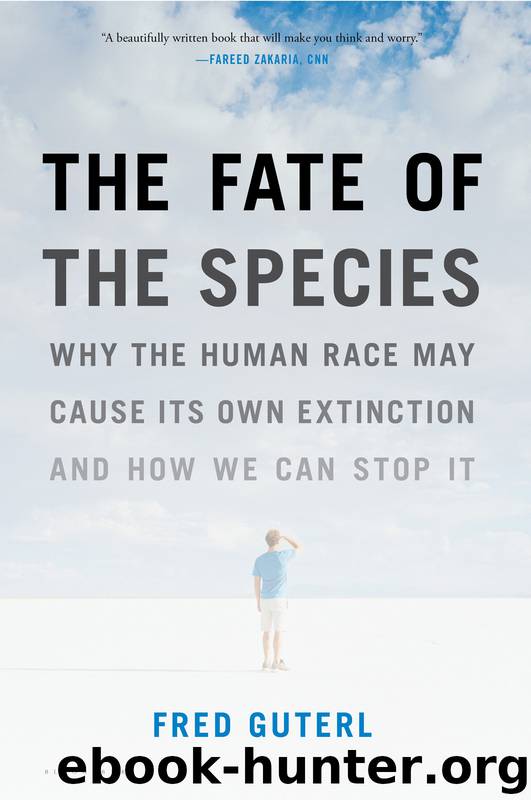The Fate of the Species by Fred Guterl

Author:Fred Guterl
Language: eng
Format: epub
Publisher: Bloomsbury Publishing
Published: 2012-03-14T16:00:00+00:00
As an undergraduate at Swarthmore, David Baltimore changed his major from biology to chemistry in part because he was less interested in birds and ecosystems than in what was going on inside the cell with big organic molecules such as DNA and proteins.9
As a young professor at MIT, Baltimore was intrigued by a class of viruses that did not use DNA as the medium for holding their genetic information. DNA is the genetic analog to Moses’s tablets: the genetic information written in this molecule doesn’t degrade easily. This molecule holds genetic information so that it can be passed from one generation to the next—by the standard of biology, it is stable. (DNA mutates from one generation to the next, but that’s a different story.) Baltimore’s curiosity drew him to viruses that were not made out of DNA at all, but were instead built of the much less stable RNA molecule.
How could a virus live and propagate and infect humans for hundreds and thousands of years without disappearing into the shifting sands of biochemistry, yet be built out of the molecular equivalent of gossamer? RNA’s role in the cell’s chemistry was thought at the time to be restricted to not much more than carrying messages from one end of the cell to the other and then collapsing like a runner at the end of a marathon. Yet many of the worst viruses—HIV, polio, influenza—are built of the stuff.
Baltimore zoomed in on the question of how an RNA virus, once it gets inside the cell, manufactures the DNA it needs to influence the cell’s behavior. Viruses, like Mary Shelley’s monster, are not quite alive, but they’re not quite dead, either. They cannot reproduce without borrowing (and ultimately destroying) the cellular machinery of a host cell. Without a host, they cannot turn food into energy; they are a bag of inert chemicals. Baltimore discovered the enzyme that viruses use to convert their RNA into DNA inside the cell—an enzyme called reverse transcriptase. Baltimore shared a Nobel Prize for the discovery in 1975, at the age of thirty-seven.
Years later, Baltimore wondered if it might be possible to build his own viruses from scratch—from a scaffolding of genetic material assembled in the lab. Using what at the time was cutting-edge technology—a technology closely related to genetic sequencing, which allowed biologists to manufacture long strands of DNA molecules—Baltimore built a DNA-negative of the polio virus, kind of a molding cast for polio’s RNA genome. If DNA’s double helix is like a twisted ladder, RNA is a single side of the ladder, split in the middle, with broken steps of varying sizes hanging off it. Baltimore built a DNA molecule that had only a single strand—one leg of the ladder—and then used this single-stranded DNA to piece together RNA that matched it. In this way, he thought he might be able to piece together an entire RNA genome of a polio virus.
Baltimore strung together the DNA for polio and, using reverse transcriptase, built his RNA genome.10 Then he injected it into mammalian cells.
Download
This site does not store any files on its server. We only index and link to content provided by other sites. Please contact the content providers to delete copyright contents if any and email us, we'll remove relevant links or contents immediately.
Man-made Catastrophes and Risk Information Concealment by Dmitry Chernov & Didier Sornette(5951)
The Revenge of Geography: What the Map Tells Us About Coming Conflicts and the Battle Against Fate by Kaplan Robert D(4052)
Zero Waste Home by Bea Johnson(3804)
COSMOS by Carl Sagan(3585)
Good by S. Walden(3516)
In a Sunburned Country by Bill Bryson(3506)
The Fate of Rome: Climate, Disease, and the End of an Empire (The Princeton History of the Ancient World) by Kyle Harper(3030)
A Wilder Time by William E. Glassley(2833)
Camino Island by John Grisham(2778)
Organic Mushroom Farming and Mycoremediation by Tradd Cotter(2660)
The Ogre by Doug Scott(2657)
Human Dynamics Research in Smart and Connected Communities by Shih-Lung Shaw & Daniel Sui(2479)
Energy Myths and Realities by Vaclav Smil(2461)
The Traveler's Gift by Andy Andrews(2433)
9781803241661-PYTHON FOR ARCGIS PRO by Unknown(2341)
Inside the Middle East by Avi Melamed(2325)
Birds of New Guinea by Pratt Thane K.; Beehler Bruce M.; Anderton John C(2235)
A History of Warfare by John Keegan(2210)
And the Band Played On by Randy Shilts(2163)
